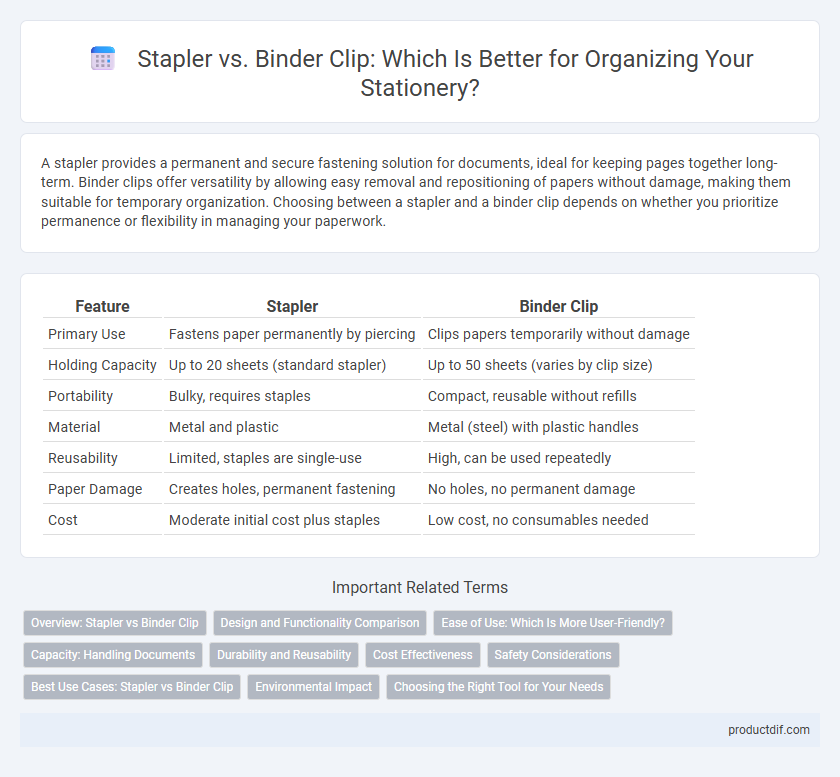A stapler provides a permanent and secure fastening solution for documents, ideal for keeping pages together long-term. Binder clips offer versatility by allowing easy removal and repositioning of papers without damage, making them suitable for temporary organization. Choosing between a stapler and a binder clip depends on whether you prioritize permanence or flexibility in managing your paperwork.
Table of Comparison
| Feature | Stapler | Binder Clip |
|---|---|---|
| Primary Use | Fastens paper permanently by piercing | Clips papers temporarily without damage |
| Holding Capacity | Up to 20 sheets (standard stapler) | Up to 50 sheets (varies by clip size) |
| Portability | Bulky, requires staples | Compact, reusable without refills |
| Material | Metal and plastic | Metal (steel) with plastic handles |
| Reusability | Limited, staples are single-use | High, can be used repeatedly |
| Paper Damage | Creates holes, permanent fastening | No holes, no permanent damage |
| Cost | Moderate initial cost plus staples | Low cost, no consumables needed |
Overview: Stapler vs Binder Clip
Staplers securely fasten multiple sheets of paper by driving a metal staple through them, making them ideal for permanent document binding. Binder clips use a spring-loaded metal clamp to hold papers together without puncturing, providing a reusable and adjustable solution for temporary or frequently modified stacks. Both tools serve essential roles in office organization, with staplers offering durability and binder clips offering flexibility.
Design and Functionality Comparison
Staplers feature a compact design with a hinged metal mechanism that punctures and binds paper using staples, ideal for permanent document fastening. Binder clips offer a spring steel construction with foldable arms, providing a reusable and adjustable grip without damaging the paper. The stapler excels in secure, long-term binding, while binder clips deliver versatility and easy document management.
Ease of Use: Which Is More User-Friendly?
Staplers require aligning paper edges correctly and applying pressure, which can be challenging with thick stacks, while binder clips simply clamp papers together without precise alignment. Binder clips are easier to remove and reposition, making them more user-friendly for temporary binding or frequent access. Staplers provide a more permanent hold but involve more effort compared to the straightforward operation of binder clips.
Capacity: Handling Documents
Staplers typically handle between 10 to 30 sheets of paper depending on the model, making them ideal for moderate document binding. Binder clips provide greater capacity, often securing up to 100 sheets or more, accommodating bulkier stacks without damaging the paper. Choosing between them depends on the volume and permanence of the document organization needed.
Durability and Reusability
Staplers provide strong, permanent fastening but can damage paper and require new staples, reducing reusability. Binder clips offer durable, non-permanent holds that protect documents and can be reused multiple times without wear. Their metal construction ensures longevity and consistent performance, making binder clips more durable and reusable for temporary organization.
Cost Effectiveness
Staplers typically require replacement staples and occasional maintenance, leading to ongoing costs, while binder clips offer a reusable and durable alternative without consumables. Binder clips can securely hold larger stacks of paper compared to standard staplers, enhancing efficiency and reducing the need for multiple fasteners. Businesses seeking cost-effective stationery solutions often benefit from the longevity and versatility of binder clips over traditional staplers.
Safety Considerations
Staplers pose a risk of finger injury due to their sharp metal staples and pressing mechanism, requiring careful handling and supervision during use. Binder clips offer a safer alternative by securely clamping papers without penetrating them, minimizing the chance of accidental punctures or cuts. When prioritizing safety in office or school environments, binder clips reduce hazards associated with frequent paper fastening and removal.
Best Use Cases: Stapler vs Binder Clip
Staplers are ideal for permanently fastening multiple sheets of paper together, providing a tidy and durable binding solution for reports, documents, and presentations. Binder clips excel at temporarily holding stacks of paper without leaving holes, making them perfect for organizing, easy removal, and preventing paper damage. For long-term document binding, staplers are best, while binder clips offer versatility and reusability for dynamic or frequently updated paperwork.
Environmental Impact
Staplers consume metal staples and often require plastic components, contributing to landfill waste and resource depletion. Binder clips are reusable, made primarily of metal, and reduce the need for single-use staples, resulting in a lower environmental footprint. Choosing binder clips over staplers supports waste reduction and promotes sustainable office practices.
Choosing the Right Tool for Your Needs
Staplers securely fasten multiple sheets of paper by embedding metal staples, making them ideal for permanent binding in office and school settings. Binder clips provide a flexible alternative, holding stacks of paper together without puncturing, perfect for documents that require frequent rearranging or temporary binding. Selecting between a stapler and a binder clip depends on the permanence, volume of papers, and the need for easy access or reorganization.
Stapler vs Binder clip Infographic

 productdif.com
productdif.com